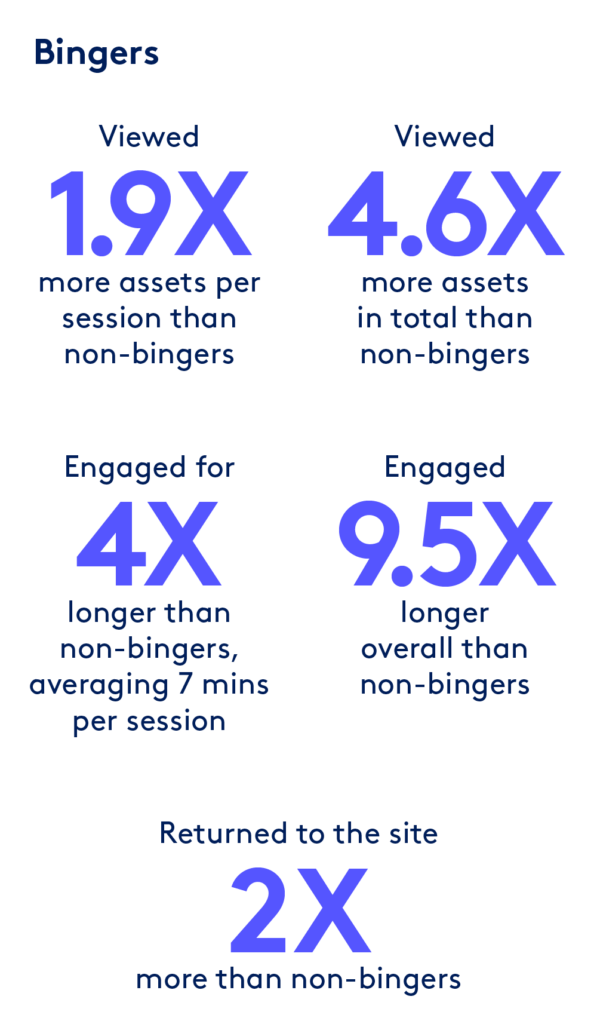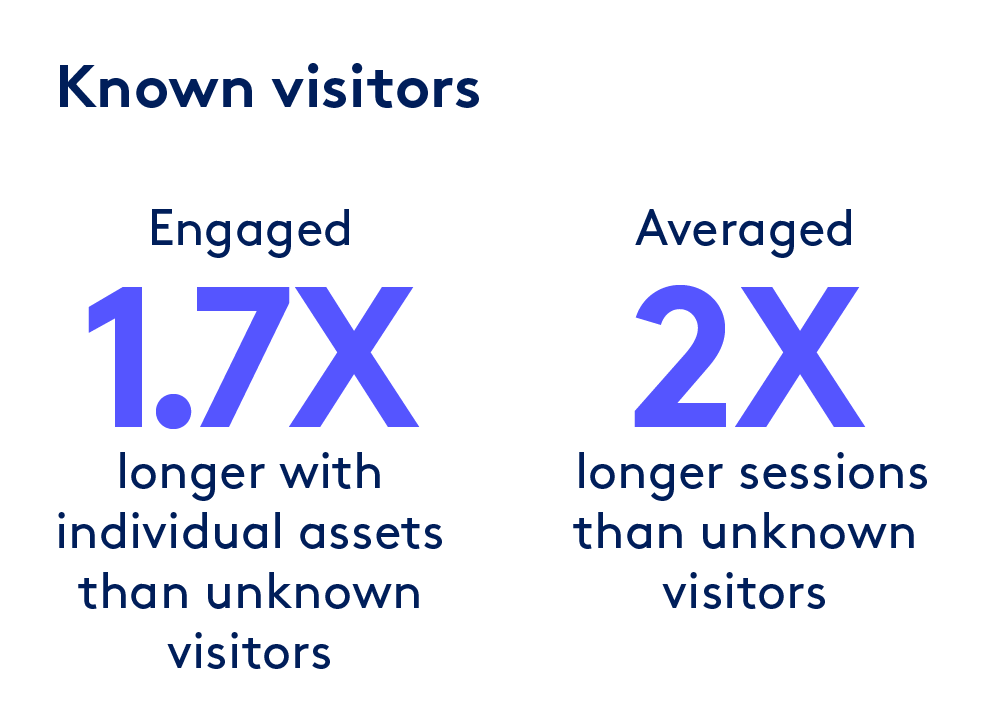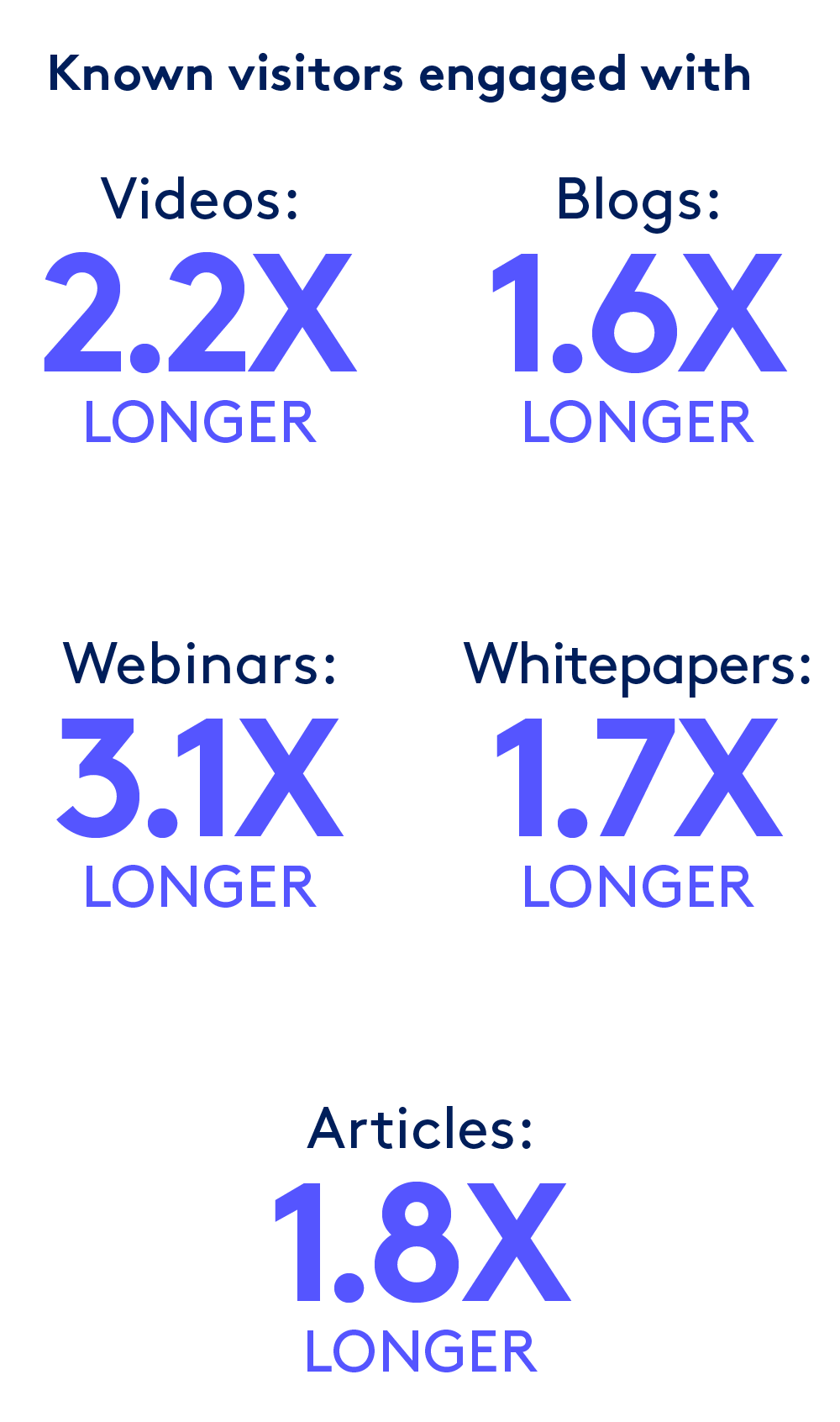
For too many B2B marketers, “personalization” simply means categorizing visitors based on demographic information, like industry, job title, or account. The problem is, within these groups, everyone is treated exactly the same. This isn’t going to cut it, especially given the complexity of today’s B2B buyer’s journeys. If you want to keep up with buyer demands for hyper-relevant content at every touchpoint, it’s time to shift gears and start thinking about them in context of their evolving relationship with your organization, rather than general labels.
But how are you supposed to do that when you don’t know who they are? Even if websites can’t identify individuals with the same speed and ease as they could in the heyday of third-party cookies and data, it’s still possible to provide a better experience based on more meaningful attributes than demographics. One of the biggest distinctions is whether a visitor is known or unknown to your marketing automation platform, or other tools in your tech stack. Another is how they actually interact with your content — whether that’s casually skimming a blog post, or bingeing on multiple assets that pull them deeper into your website.
PathFactory’s 2021 Content Engagement Report identified significant variations in visitor behavior, based on content engagement data pulled from millions of sessions and thousands of assets across hundreds of organizations. Here’s what you need to know about different types of visitors and how they engage with content:
Bingers vs. Non-Bingers
Bingers are visitors who view two or more assets in a single session. They also engage longer and more often than other visitors. In PathFactory’s 2021 Content Engagement Report, we saw that bingers:
- Viewed 1.9X more assets per session than non-bingers
- Viewed 4.6X more assets in total than non-bingers
- Engaged for 4X longer than non-bingers, averaging 7 minutes per session
- Engaged 9.5X longer overall than non-bingers
- Returned to the site 2X more than non-bingers
Bingeing is the best way to predict sales readiness, as this behavior typically appears as visitors move deeper into the funnel. The problem is, typical marketing analytics solutions lump bingers together with everyone else, making them harder to spot at both an individual and account level. When actual visitor behavior is integrated into the data, marketers can suddenly answers questions like:
- Which format is prompting more visitors to binge?
- Is there a disconnect between how often you’re distributing a certain type of content, and how frequently it drives binge behavior?
- Do more visitors binge after viewing a particular asset?
Understanding how bingers interact with your content is important, so you can optimize and encourage more visitors to join them. However, that’s only one piece of the puzzle. Your content engine also needs to be equipped to drive binge behavior in the first place.
One of the reasons why bingers spend more time with more assets than non-bingers is because they’re encountering relevant content. This is also why bingers return twice as often as non-bingers — from their perspective, if your site has already delivered content they’ve found useful, it stands to reason that they’ll find even more if they come back. These return visits also drive up total session time and number of asset views — another reason why relevancy is now make-or-break on B2B websites.
But relevancy is often a moving target, as visitors want and need different information at various stages of the buyer’s journey. That’s why marketers are now leveraging AI-enabled technology like content intelligence, which assesses visitor behavior in real-time, and determines which assets are most relevant at an individual, account or industry level.

Known vs. Unknown Visitors
Similar to bingers, known visitors are typically associated with more engagement. PathFactory’s 2021 Content Engagement Report found known visitors:
- Engaged 1.7X longer with individual assets than unknown visitors
- Averaged 2X longer sessions than unknown visitors

Known visitors not only engage longer with B2B websites than their unknown counterparts, but also with specific types of content:
- Videos: 2.2X longer
- Blogs: 1.6X longer
- Webinars: 3.1X longer
- Whitepapers: 1.7X longer
- Articles: 1.8X longer

The good news is, the average number of known visitors per account has increased by 50%, thanks to increasing focus on ABM/ABX efforts. There was also an 87% increase in the number of larger accounts totalling 10+ visitors — with at least five known — compared to 2020. At the same time, the average percentage of known visitors decreased by 26.9%. This indicates that marketers are reaching even more unknown accounts, as ABM programs continue to expand and mature.
Similar to binge behavior, increased account visibility typically correlates with prospects moving deeper into the funnel. However, it’s not quite that simple. For starters, visitors are remaining anonymous for longer. With third-party data on its way out the door, organizations need to find better ways to determine and deliver the most relevant content. With PathFactory, for example, marketers can tap 6sense data to identify which accounts are engaging with different assets — even if the individuals themselves are still unknown. This recently expanded integration also provides mutual customers with more advanced predictive models, combining PathFactory content intelligence with 6sense intent data.
Account matching technology drastically improves the buyer’s journey, which has been traditionally riddled with friction and forms. Since marketers can now generate meaningful insights based on rich content, visitor, and intent data — regardless of whether the identity of an individual visitor is known — this reduces dependency on hard-gated assets. At the same time, organizations can more accurately identify which visitors or accounts are engaged, rather than who bothered to fill out a form or hand over their contact information (which may not even be accurate).
Back to you
With the size, scope and complexity of today’s buyer’s journeys, marketers can no longer afford to overlook significant differences between bingers, non-bingers, known and unknown visitors when it comes to content consumption. Delivering the right content, to the right people, at the right time now depends on understanding visitors beyond segment or account — but how they actually engage with your content.
PathFactory’s 2021 Content Engagement Report uncovered a dramatic shift around B2B content consumption, engagement, activation and distribution. Jump in to read about these changes and what they mean for marketers in the post-pandemic era.
